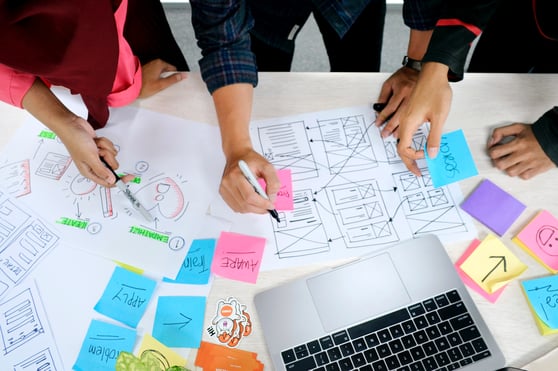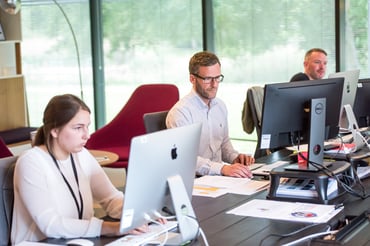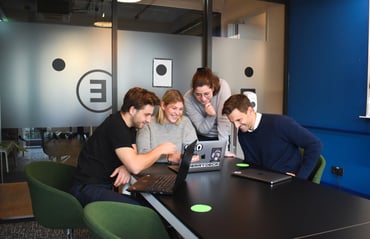More and more businesses are shifting from a user-centered design process to a collaborative experience as companies see the potential to benefit from their customer’s ideas and suggestions as a way to improve their products and services. This change also involves a shift in perspective from designing for users to designing with users. Such an emerging design movement necessitates a fresh approach to thinking, feeling, and working.
Customer co-creation isn't just another design process; it's a mindset and an attitude toward your end users. It's the conviction that each customer has something valuable to contribute to the design process and that they possess the ability to effectively communicate their ideas when provided with the right tools for expression.
What is Customer Co-Creation?
Customer co-creation is a powerful design concept that lies at the heart of modern innovation strategies. It's a collaborative methodology that brings together customers and businesses to jointly create, design, and develop products, services, or solutions.
This approach recognizes that customers possess valuable insights, needs, and preferences that can shape the direction in which your products develop. By engaging customers as active participants, companies gain access to a source of diverse ideas, experiences, and knowledge, strengthening a deeper connection with their audience and creating solutions that truly resonate. Customer co-creation transforms the relationship between a business and its customers, transforming them from passive consumers to active collaborators on the path to innovation.

User-Centered Design Process vs. Customer Co-Creation
In the user-centered design process, companies shape the product, service, or communication to align with user needs. The user researcher acts as the pipeline connecting the user with the designer. This researcher gathers primary or secondary user data, interpreting it into design criteria. The designer then translates these criteria into concept sketches, requirements, and scenarios, all aimed at developing the final product. Sometimes, the researcher and user re-enter the process for usability testing.
Within this framework, the roles of the researcher and designer remain distinct but interconnected, with the user's voice channeled through the researcher.
However, in customer co-creation, the boundaries between the designer and researcher roles dissolve, and the user takes on the main role in the process. This shift encourages cultivating a 'customer instinct' across the entire organization, not limited to the research team, promoting a culture of involvement, open innovation, and a clearer understanding of user needs.
How to Co-Create With Customers?
Co-creating with customers is a dynamic and iterative process that requires a strategic and open-minded approach. Here we discuss the most important tips that could help you to succeed in the process:
Identify the Right Customers to Collaborate with
These are usually the people who are not only passionate about your company or product but also ready to express their opinion and actively participate.
Create a Favorable Environment for Engagement
Through online platforms, workshops, or focus groups where customers can freely share their ideas and insights.
Provide the Necessary Tools and Resources
That could include anything from software to technology.
Embrace Experimentation
Encourage the exploration of various ideas and concepts.
Listen Actively
By valuing and incorporating customer feedback, companies demonstrate their commitment to co-creation.
Reward Customers You Collaborate with
These can be discounts, small gifts, or promotional packages. Express gratitude to your collaborators.
Ultimately, successful customer co-creation is built on mutual respect, shared goals, and the belief that together, companies and customers can achieve innovation that truly makes a difference.
.jpg?width=640&height=427&name=brooke-cagle--uHVRvDr7pg-unsplash%20(1).jpg)
Co-Creation Examples
Heineken
Heineken created a groundbreaking design project called "Open Design Explorations," which was presented at the Milan Design Week in 2016. The project extended an invitation to emerging designers hailing from New York City, São Paulo, Tokyo, and Milan to embark on a collaborative and innovative journey. The objective of this initiative is to collectively conceive and create a trailblazing nightclub experience. To infuse this project with creativity and authenticity, Heineken, in collaboration with a prominent market research agency, established an interactive online research community comprising more than 100 clubbers from diverse global locations.
Heineken's "Open Design Explorations" was a testament to the power of co-creation, where the collaborative efforts of designers and clubbers converged to shape a nightlife experience that transcends conventional boundaries. Through this initiative, Heineken demonstrated its commitment to leveraging customer insights and design expertise to create a memorable and impactful nightclub experience that resonates with a global audience.
Liebherr
Liebherr's approach to customer co-creation is a structured and comprehensive process that involves multiple phases. The company initiated the "Wine Experience" project, which engaged its customer community in shaping innovative solutions for wine coolers.
First, Liebherr formed an online research community with existing and potential wine cabinet customers, identifying their pain points. In the second phase, the company refined these insights with the help of internal teams. The third phase involved launching a customer crowdsourcing campaign, and the final phase included expert evaluation of the generated ideas. This structured approach resulted in a significant number of innovative ideas and enthusiastic support from top management, showcasing the value of customer co-creation.
To learn more about Liebherr's successful implementation of a customer co-creation program, read the full article: https://www.hypeinnovation.com/blog/co-creation-with-customers-liebherr-open-innovation-case-study
Final Thoughts
Customer co-creation isn't a mere set of methods, it's a mindset that recognizes everyone's potential to contribute valuably to the design process. It transforms the traditional business-customer relationship, turning passive consumers into active innovation collaborators that can impact the business's success.










